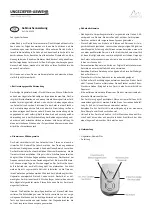
Startup and operation
RES-430
Page 25
The measuring principle applied for this system
necessitates a heatsealing band alloy with a suitable
temperature coefficient TCR, i.e. one whose resistance
increases as the temperature rises.
Too low a TCR leads to oscillation or uncontrolled
heating.
When heatsealing bands with a higher TCR are used,
the controller must be calibrated for this.
The first time the heatsealing band is heated to
approximately 200…250°C, the standard alloy
undergoes a once-only resistance change (burn-in
effect). The cold resistance of the heatsealing band is
reduced by approximately 2…3%. However, this at first
glance slight resistance change results in a zero point
error of 20…30°C. The zero point must therefore be
corrected after a few heating cycles (
ª
"Burning in the heatsealing band" on page 25).
One very important design feature is the copper or
silver-plating of the heatsealing band ends. Cold ends
allow the temperature to be controlled accurately and
increase the life of the teflon coating and the
heatsealing band.
An overheated or burned-out heatsealing
band must no longer be used because the
TCR has been altered irreversibly.
9.6.2
Burning in the heatsealing band
If a new heatsealing band has been used, the zero
point is first of all calibrated while the band is still cold
by activating the "AUTOCAL" function on the controller.
When the "AUTOCAL" function has finished, the
display shows the preselected calibration temperature
(default value: 20°C). Adjust the set point to
approximately 250°C and press the "HAND" key
(display in home position) to activate the "START"
signal and heat for approximately 1 second. After
recooling, the controller usually indicates a value less
than 20°C. Repeat the "AUTOCAL" function. The
heatsealing band has now been burned in and the
change in the alloying properties stabilized.
The burn-in effect described here does not occur if the
heatsealing band has already been thermally
pretreated by the manufacturer.
9.6.3
Replacing the heatsealing band
All power supply leads must be disconnected from the
RESISTRON temperature controller in order to replace
the heatsealing band.
The heatsealing band must be replaced in
accordance with the instructions provided by
the manufacturer.
Each time the heatsealing band is replaced, the zero
point must be calibrated with the AUTOCAL function
while the band is still cold, in order to compensate
production-related resistance tolerances. The burn-in
procedure described above must be performed for all
new heatsealing bands.
9.7
Startup procedure
Please also refer to section 2 "Application" on page 4.
Installation and startup may only be
performed by technically trained, skilled
persons who are familiar with the associated risks
and warranty provisions.
9.7.1
Initial startup
Prerequisites: The controller must be correctly installed
and connected (
ª
section 8 "Installation" on page 12).
The possible settings are described in detail in
section 9.2 "General controller configuration" on
page 17 and section 10 "Controller functions" on
page 27.
The essential controller configurations are described
below:
1. Switch off the line voltage and verify that all circuits
are deenergized.
2. The supply voltage specified on the nameplate of
the controller must be identical to the line voltage
that is present in the plant or machine. The line
frequency is automatically detected by the
temperature controller in the range from 47 to 63Hz.
3. Heed the information contained in the ROPEX
Application Report as well as the specifications for
the heatsealing band that is used (section 9.2
"General controller configuration" on page 17).
4. Make sure that a START signal is not present.
5. Switch on the line voltage.
6. A power-up message appears on the display for
approximately 2 seconds when the controller is
switched on to indicate that it has been started up
correctly.
!
!
!
















































